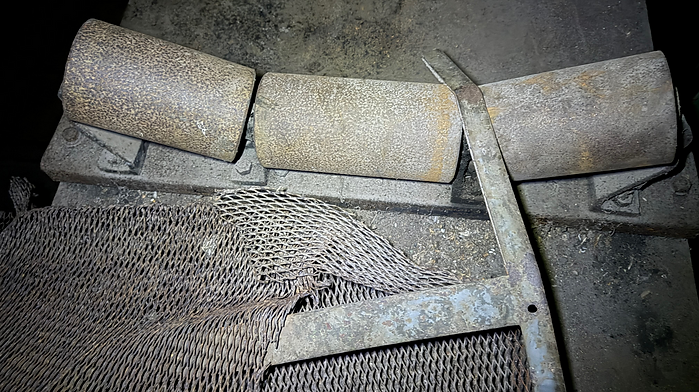

Cast iron bulkhead lamps were located along the conveyors and in the crusher house. It’s a typical industrial-type fixture that was common between the 1940s to 1970s and securely flush-mounted in place on the steel flange of the truss.
A fitting like a B22 bayonet cap was typically located in the centre of the ceramic housing, like you’d find today where lightbulbs are used.
The convex light cover was constructed from thick plastic to prevent impacts, dust and moisture from infiltrating the light and damaging the bulb.
Conveyor Gallery & Crusher House

The conveyor gallery is known by a number of different names but all depict the same thing with its long, enclosed structure housing a conveyor belt system between buildings and above ground level.
They're commonly found at power stations, mining operations and processing facilities, which involve heavy materials like coal and ore. Construction of the gallery is typically made with steel and supported internally with trusses or steel frames.
The conveyor gallery started near the coal tippler, where coal was delivered. It then transported the coal upwards into the crusher house. A number of different processes took place here.
-
Vibrating screens were installed to remove foreign materials, debris and big coal lumps.
-
Magnet separators were used to remove metal objects like screws, tools and other minerals. Collie coal tended to have a lot of scrap iron more than anything else. Removing foreign items helped to prevent equipment damage, particularly the conveyor belt and wearing out the crusher. It also improved the boiler’s efficiency as clean coal burns better, minimized the pollutants in the ash and emissions, whilst limiting foreign objects that could spark a fire or explosions.
-
Heavy duty machines then broke down big lumps of coal to make them more manageable for efficient combustion. It also helped to prevent overloading of the conveyor belt and blockages in the chutes.
A second conveyor gallery then took the coal upwards due north to the boiler house (only a section of the frame exists today), where the coal would be dropped into the bunkers below (sometimes referred to as coal bins), which are located above the boilers.
Until some time in the early 1990s, the extensive underground bunkers and reinforced concrete tunnels was said to be intact.
Bulk Material Conveyor Gallery

Bulk Material Conveyor Galleries like this can be found in facilities like power stations, mines and grain terminals, although the steel truss system was perhaps more common during the mid-20th century.
Two parallel conveyor belts helped to transport a maximum level of coal to the top of the boiler house, although the power station converted to burning furnace oil between 1968 and 1974.
Catwalks ran along the conveyor belts for ease of access to the rollers, equipment and coal.
In cases where the conveyor needed to be stopped to remove items from the coal (or for any other reason), emergency stop buttons were located along the conveyor and inside the crusher house.
The floor consisted of metal grating, which enabled ventilation whilst the conveyor was in use.
A build-up of coal dust could cause the belt to slip or affect the function of rollers and idlers. During shutdowns and maintenance work, conveyor belts could be hosed down. The water drained through the mesh to the ground below, along with any other debris, which also helped create a cleaner workplace with less airborne particles.
Hosing was likely done at key points in the transfer station, crusher discharge belt and boiler feed areas. The sloped floors enabled the water to run-off and drain.
Conveyor Belts

The conveyor belt system, with a roller idler assembly, consisted of three rollers with two angled upwards. They were held in a steel frame, which was connected to the conveyor structure.
The 3-roll configuration supported the belt and helped form a trough shape to minimize spillage, as it conveyed the coal upwards. It's still commonly used today in mines, quarries and cement plants, particularly as it stabilizes the belt and the load and enables a higher quantity of material, coal in this case, to be transported from one area to another.
It’s very likely the conveyor belt, transporting the coal to the bunkers, was of a 12-16mm standard coal handling thickness.
Heavy-duty coal handling like iron ore, usually requires 18-25mm thick belts or more.
Steel Truss System

The green-painted structural steel beams, forming the roof of the conveyor gallery, consists of angled and rectangular hollow sections, which converge to form large triangles.
A gusset plate, connected with multiple hex bolts, reinforces the junction of the beams. This distributes the stress and strengthens the connection, a fundamental design of truss systems.
The green paint was likely applied to prevent rusting.
Crusher House Windows

Rolled steel muntin windows in the crusher house were the typical steel-framed multi-pane windows that were common in early-to-mid-20th century industrial buildings like power stations, rail sheds and WW1 and WW2 buildings.
Rolled steel muntins refer to the narrow metal strips in between the window panes. It’s made from a metalwork process called rolling, which ensures the metal is given a consistent cross section when it passes through the rollers. It’s far stronger than timber and doesn’t burn, which needs to be considered in an environment that processes coal, which is prone to catching on fire.
Smaller window panes are easier to replace than big ones if they were to break. It also allowed for more glass surface, therefore allowing more light than a wood muntin window, which needs to be thicker in order to support the glass panes.
Steel muntins could be as thin as 5mm, with wooden muntins needing to be on average, a minimum of 15mm. Wood requires more bulk to offer the same support steel does and for long-term stability. It gives them better resistance to weathering as they can warp, split or crack over time with humidity and exposure to the sun.
Bulkhead Lamps






